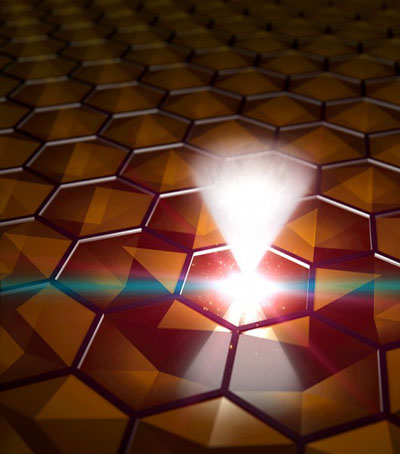| Posted: Apr 21, 2015 |
Electrons move like light in three-dimensional solid
|
|
(Nanowerk News) Electrons were observed to travel in a solid at an unusually high velocity, which remained the same independent of the electron energy. This anomalous light-like behavior is found in special two-dimensional materials, such as graphene, but is now realized in a three-dimensional bulk material. High-resolution angle-resolved electron spectroscopy, stimulated by synchrotron x-ray radiation, was used to substantiate the theoretically predicted exotic electron structure.
|
 |
| Artist’s conception highlighting key features of electron behavior in bulk sodium bismuth and cadmium arsenic. The interactions in the three-dimensional lattice lead to electrons that travel at a fixed velocity, independent of the electron’s energy state.
|
|
The Impact
|
|
A stable bulk material has been discovered that shows the same physics found in graphene, which illuminated the detailed interactions of electron’s orbital motion and its intrinsic magnetic orientation. The new material will be a test ground for theories on how electron interactions in solids shape exotic electron behavior, including the highest electron mobility in bulk materials.
|
|
Summary
|
|
Investigations of electronic behavior have expanded beyond familiar systems of metals, insulators, and semi-conductors into the realm of strongly interacting electrons, which exhibit exotic relationships between the allowed electron velocities and their energy states. A key feature for the new materials is behavior in which the electron velocity does not depend on its energy. Such a relationship is a hallmark of photons, the energetic particles that make up a beam of light. This property is found in the new class of materials exhibiting a strong interaction between the electron trajectory and the electron spin alignment (called “spin-orbit coupling”). Two-dimensional versions of such systems (for example, graphene) have been recently explored, but the systems are hard to work with because of their ultra-thin film nature.
|
|
This work establishes graphene-like electronic behavior in the bulk three-dimensional materials Na3Bi and Cd3As2 and explains their exceptionally high electronic mobility. The required advances in electron spectroscopy techniques, used to investigate the electronic structure, employed an energy tunable bright x-ray source and a high-resolution spectrometer.
|
|
Publications
|
|
Science "Discovery of a three-dimensional topological Dirac semimetal, Na3Bi"
|
|
Nature Materials, "A stable three-dimensional topological Dirac semimetal Cd3As2"
|
|
Nature Communications "Observation of a three-dimensional topological Dirac semimetal phase in high-mobility Cd3As2"
|

